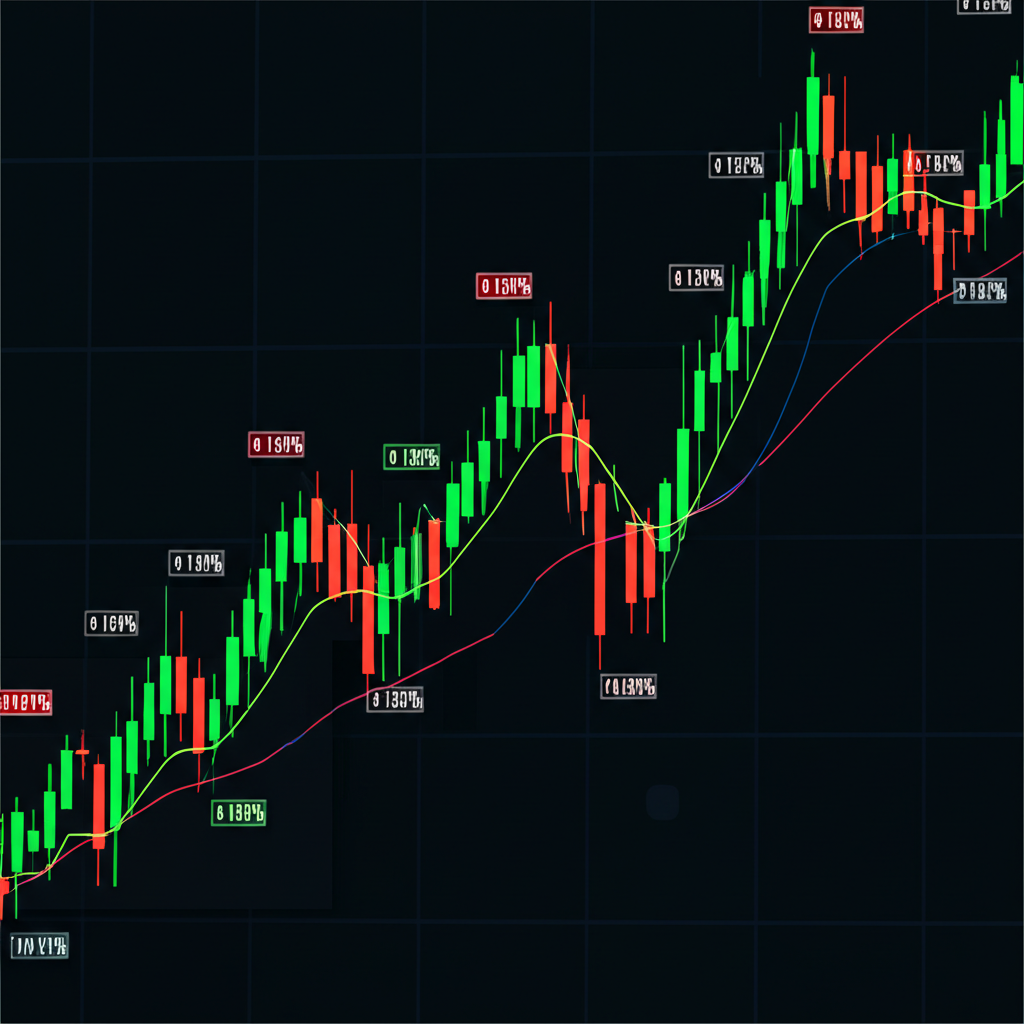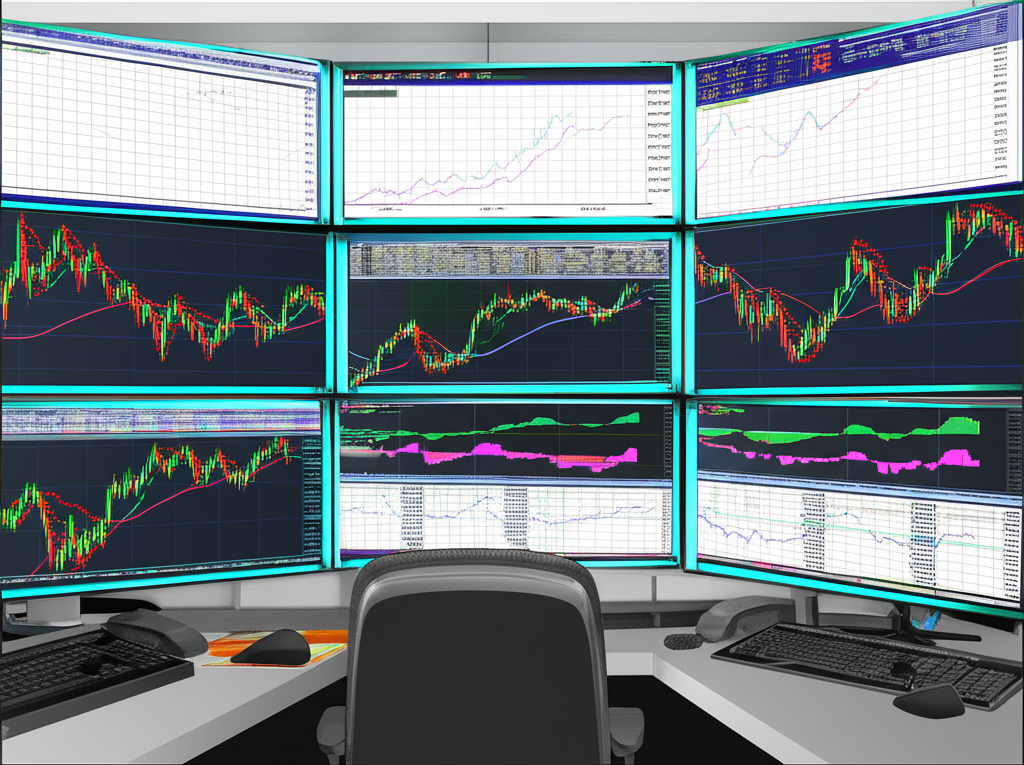Introduction to DAX 30: What is it and Why Predict?

The DAX 30, often referred to as the GER30, serves as a cornerstone of the German financial landscape and one of the most watched barometers of European market health. Comprised of the 30 largest and most actively traded companies on the Frankfurt Stock Exchange, this index captures the performance of industry titans across sectors—from automotive leaders such as Volkswagen and Mercedes-Benz to industrial innovators like Siemens and pharmaceutical giants including Bayer. Its movements are closely monitored not just by domestic investors but by global markets, as shifts in the DAX often signal broader economic trends within the Eurozone. For traders and portfolio managers, anticipating where the index is headed—whether over the next few hours or the coming years—offers a strategic edge. Accurate forecasting enables better risk assessment, more precise trade timing, and improved capital allocation in one of Europe’s most influential equity benchmarks.
Current DAX 30 Price & Live Market Overview

The DAX 30 is far from static—it reacts in real time to a complex web of economic signals, geopolitical developments, and investor psychology. Tracking its current price action offers immediate insight into market confidence or caution. Recent sessions have been marked by alternating surges and pullbacks, driven by everything from U.S. inflation reports to shifts in ECB policy expectations and corporate earnings surprises from major index constituents. Traders rely on live charts to monitor intraday momentum, volume spikes, and price patterns that may foreshadow larger moves. These visual tools help distinguish between noise and meaningful trend shifts. Overall sentiment toward the DAX 30 is shaped not only by the performance of German multinationals but also by broader concerns about energy stability, supply chain resilience, and the Eurozone’s ability to maintain growth amid global headwinds.
DAX 30 Forecast Today & Tomorrow: Short-Term Technical Analysis

When it comes to predicting the DAX 30’s next move in the near term—be it within the day or over the next few trading sessions—technical analysis becomes an essential toolkit. Traders use historical price data, volume behavior, and mathematical indicators to identify patterns that suggest where prices might go next. By analyzing chart formations and momentum signals, investors can position themselves ahead of potential breakouts or reversals, improving the probability of successful trades.
Key Support and Resistance Levels for DAX 30

Support and resistance levels act as psychological and structural anchors in the market. Support marks a zone where demand tends to outweigh supply, halting downward movement and potentially triggering a rebound. Resistance, on the other hand, is where selling pressure typically emerges, capping upward progress. For the DAX 30, these levels often align with previous swing highs and lows, round numbers, or areas where price has paused repeatedly. For instance, a level like 18,000 may serve as a strong support, drawing buyers if tested, while 18,500 could act as a resistance ceiling. Traders use these reference points to plan entries, exits, and stop-loss placements, making them vital for disciplined execution.
Momentum Indicators: RSI, MACD, and Stochastic Oscillator
Momentum indicators help assess the strength and sustainability of price movements, offering early warnings of potential reversals or continuation patterns.
- Relative Strength Index (RSI): This oscillator measures recent price changes to determine whether the DAX 30 is overextended. Readings above 70 suggest overbought conditions, which may precede a pullback, while values below 30 point to oversold territory, potentially signaling a bounce. Divergences—such as price making new highs while RSI fails to—can be particularly telling.
- Moving Average Convergence Divergence (MACD): The MACD tracks the relationship between two moving averages of price. A bullish crossover—when the MACD line crosses above the signal line—often signals strengthening upward momentum. Conversely, a bearish crossover hints at weakening sentiment and possible downside.
- Stochastic Oscillator: By comparing the closing price to its price range over a set period, this tool highlights potential turning points. Like the RSI, it flags overbought and oversold conditions, but it’s especially useful in range-bound markets where price oscillates between established levels.
When used together, these indicators provide a layered view of market momentum. For example, an oversold RSI combined with a bullish MACD crossover could signal a high-probability buying opportunity, especially if supported by price holding at a key level.
Trend-Following Tools: Moving Averages and Bollinger Bands
To confirm the direction and durability of a trend, traders turn to trend-following indicators that smooth out price noise and highlight directional bias.
- Moving Averages (MAs): The 50-day and 200-day exponential moving averages (EMAs) are widely watched. When the DAX 30 trades above the 50-day EMA, it often reflects short-term bullish momentum. A position above the 200-day EMA suggests a longer-term uptrend. The intersection of these averages—known as a “golden cross” (bullish) or “death cross” (bearish)—is considered a significant shift in market structure.
- Bollinger Bands: These consist of a middle moving average and two outer bands set two standard deviations away. They expand during periods of high volatility and contract during calm phases—a phenomenon known as the “Bollinger Squeeze,” which often precedes sharp price moves. When the DAX touches the upper band, it may be overbought; when it hits the lower band, oversold. However, in strong trends, price can ride along the bands, so interpretation must consider context.
These tools help traders distinguish between genuine trends and temporary fluctuations, guiding decisions on whether to follow the trend or anticipate a reversal.
Long-Term DAX 30 Outlook: Fundamental Analysis & Economic Drivers
While technicals dominate short-term trading, the long-term path of the DAX 30 is shaped by deeper structural forces. Fundamental analysis digs beneath price charts to evaluate the health of the German economy, corporate profitability, and the policy environment that shapes investor confidence.
Impact of German & EU Economic Data
The DAX 30 is deeply intertwined with the economic pulse of Germany and the Eurozone. Key indicators offer a window into future corporate performance and market direction:
- Gross Domestic Product (GDP): Sustained GDP growth supports earnings expansion and consumer demand, lifting corporate valuations. A contraction, however, can trigger risk-off behavior and weigh on equity prices.
- Consumer Price Index (CPI): Inflation data influences both consumer spending and central bank decisions. Persistent high CPI may prompt tighter monetary policy, increasing borrowing costs and pressuring equities.
- Unemployment Rates: Low unemployment reflects labor market strength, which typically boosts consumer confidence and discretionary spending—key drivers for industrial and service-sector firms in the index.
- Industrial Production: As a manufacturing powerhouse, Germany’s industrial output is a critical metric. Strong production figures often correlate with improved performance among DAX heavyweights like Siemens, BASF, and Volkswagen.
Market participants keep a close eye on the ECB’s economic calendar for upcoming data releases from Destatis (Federal Statistical Office of Germany) and Eurostat. These reports frequently move the market, especially when they deviate from consensus forecasts.
Central Bank Policies: ECB’s Role in DAX Performance
The European Central Bank wields significant influence over the DAX 30 through its monetary policy framework. Interest rate decisions, asset purchase programs, and forward guidance directly affect liquidity, borrowing costs, and risk appetite. When the ECB maintains low rates or engages in quantitative easing, it generally supports equity valuations by making bonds less attractive and lowering corporate financing costs. Conversely, rate hikes or quantitative tightening can lead to equity de-risking, particularly in rate-sensitive sectors. Traders parse every word from ECB officials, searching for hints about future policy shifts. Even subtle changes in tone during press conferences can trigger volatility in the DAX.
Geopolitical Events & Global Market Sentiment
Global events often ripple through European markets, impacting the DAX 30 in unexpected ways. Escalating trade tensions, energy supply disruptions, military conflicts, and major elections all contribute to shifts in investor sentiment. For instance, instability in Eastern Europe can affect energy prices, directly impacting German industry. Similarly, U.S. Federal Reserve decisions influence capital flows into and out of European assets. Because the DAX includes globally exposed companies, it is sensitive to shifts in global risk appetite. During times of uncertainty, investors may flee to safe-haven assets, dragging the index lower—even if domestic fundamentals remain sound.
Advanced Forecasting Methodologies & Our Differentiated Approach
Predicting the DAX 30 with consistency requires moving beyond single-dimensional analysis. A holistic approach integrates multiple data streams and analytical frameworks to form a more resilient and adaptive outlook.
Combining Technical, Fundamental, and Quantitative Models
Reliable DAX 30 forecasts emerge from the convergence of different analytical lenses. Technical models offer actionable trade signals based on price structure and momentum. Fundamental analysis evaluates the intrinsic value of the index by examining economic health, earnings trends, and sector dynamics. Quantitative models go a step further, using statistical algorithms and machine learning to detect non-linear patterns, hidden correlations, and regime shifts that traditional methods might miss. By synthesizing insights from all three, forecasters can reduce blind spots and improve the accuracy of their predictions. This multi-layered strategy is particularly effective in volatile or transitional market environments.
The Role of Market Sentiment Beyond Indicators
Markets are not purely rational—they are driven by human behavior, emotion, and narrative. While indicators reflect past actions, understanding sentiment reveals what investors *expect* to happen. Tools like news sentiment analysis scan thousands of articles and social media posts to measure the tone around the DAX and its components. A surge in negative headlines, for example, might signal growing bearishness even before price breaks down. Similarly, sentiment gauges such as the “fear and greed” index can highlight extremes in market psychology. Excessive optimism may warn of a top, while deep pessimism can indicate a potential buying opportunity. Incorporating these behavioral insights adds a crucial dimension to forecasting, helping to anticipate turning points that pure data analysis might overlook.
Trading DAX 30 Futures: What You Need to Know
For active traders, DAX 30 Futures—commonly known as GER30 Futures—offer a powerful vehicle to gain exposure to the index with flexibility and leverage.
Understanding DAX Futures Contracts (GER30 Futures)
DAX Futures are standardized agreements to buy or sell the index at a specified price on a future date. Traded on the Eurex exchange, these contracts allow speculation or hedging without owning the underlying stocks. Each contract has a multiplier—typically €25 per index point—meaning a 100-point move equals €2,500 in value. Contracts expire quarterly (March, June, September, December), and traders often roll positions forward as expiration nears. Futures prices usually trade at a slight premium or discount to the spot index due to interest rates and dividends, a relationship known as the “basis.” Because futures reflect forward expectations, they often lead the cash index, making them a valuable leading indicator.
DAX Futures Trading Hours & Liquidity
One of the biggest advantages of DAX Futures is extended trading availability. Unlike the cash market, which operates during Frankfurt hours, futures trade nearly 24 hours a day, Monday through Friday. The core session on Eurex runs from 8:00 AM to 10:00 PM CET, but pre- and after-hours trading allows reaction to global news, such as U.S. job reports or Asian market moves. Liquidity is strongest during European daytime, ensuring tight spreads and reliable execution. Outside these hours, spreads may widen, and slippage can increase—factors traders must account for when placing orders.
Practical Trading Strategies & Risk Management for DAX
Success in DAX trading isn’t just about predicting direction—it’s about executing with discipline and protecting capital through sound risk management.
Entry and Exit Points Based on Forecasts
Forecasts become actionable when translated into clear trade setups. For example, if technical analysis identifies a breakout above 18,450—a key resistance level—a trader might enter a long position on a confirmed close above that mark, with a stop-loss just below. Conversely, if fundamental indicators point to slowing growth, a trader might use rallies to exit longs or initiate short positions. Support and resistance levels serve as natural decision points. The table below outlines a practical reference framework:
| Level Type | Value (e.g., points) | Implication |
|---|---|---|
| Key Resistance 2 | 18,600 | Strong selling pressure expected |
| Key Resistance 1 | 18,450 | Potential short-term ceiling |
| Current Price (approx.) | 18,300 | Reference point |
| Key Support 1 | 18,150 | Potential short-term rebound area |
| Key Support 2 | 18,000 | Strong buying interest expected |
This structure helps traders align their entries and exits with market structure, reducing emotional decision-making.
Essential Risk Management Techniques for DAX Traders
Given the volatility and leverage involved in DAX trading, risk control is non-negotiable.
- Stop-Loss Orders: Always define the maximum loss you’re willing to accept. For a long position at 18,300, a stop at 18,200 limits downside to 100 points. This prevents small losses from turning into large ones.
- Position Sizing: Never risk more than 1–2% of your trading capital on a single trade. This ensures survival through inevitable losing streaks.
- Managing Leverage: While leverage amplifies gains, it does the same for losses. Use it cautiously—many seasoned traders reduce leverage during periods of high uncertainty.
- Diversification: Even if focused on the DAX, consider how it fits within your broader portfolio. Overexposure to a single index increases systemic risk.
Effective risk management isn’t about avoiding losses—it’s about controlling them so you can stay in the game long enough to profit over time. Traders should also avoid holding positions through major economic announcements, as data surprises can cause price gaps that bypass stop orders.
Conclusion: Interpreting DAX 30 Previsions for Informed Decisions
Navigating the DAX 30 requires more than a single analytic lens—it demands a comprehensive, adaptive strategy that blends technical precision, fundamental depth, and behavioral insight. While no forecast can guarantee outcomes, a disciplined approach that incorporates multiple methodologies increases the odds of making well-informed decisions. Traders and investors must remain agile, continuously updating their views as new data emerges. Above all, risk management must remain the foundation of any strategy. Use DAX 30 forecasts not as crystal balls, but as analytical tools to refine your edge, spot opportunities, and protect your capital in a market shaped by countless interconnected forces.
Can I invest directly in the DAX 30, or do I need specific instruments?
You cannot directly invest in the DAX 30 index itself, as it is merely a benchmark. However, you can gain exposure to its performance through various financial instruments. These include Exchange Traded Funds (ETFs) that track the DAX 30, DAX Futures contracts (like the FDAX or GER30 Futures), Contracts for Difference (CFDs), or by investing in a portfolio of the individual constituent stocks that make up the index.
What is the current forecast for DAX stock performance this week?
Short-term forecasts for DAX 30 performance this week typically rely on technical analysis, key support/resistance levels, and upcoming economic data releases from Germany and the Eurozone. While specific predictions vary, current sentiment is often driven by momentum indicators like RSI and MACD, alongside the performance of key sectors within the index. Traders should monitor daily market updates and technical charts for real-time insights.
Beyond its definition, what are the primary components of the DAX 30 index?
The DAX 30 (soon to be DAX 40) is composed of Germany’s 30 largest and most liquid blue-chip companies traded on the Frankfurt Stock Exchange. These include globally recognized names such as Volkswagen, Siemens, SAP, Allianz, Mercedes-Benz Group, and Bayer. The index is weighted by market capitalization, meaning companies with higher market values have a greater impact on the index’s overall movement.
Is there any significant difference between DAX 30 and GER30 in trading terms?
No, there is generally no significant difference in trading terms. DAX 30 is the official name of the German stock index. GER30 is a common alternative ticker symbol used by many CFD brokers and trading platforms to refer to the same index. They both represent the same underlying market, and their price movements are identical.
How reliable are historical “prevision dax 30 price” analyses for future predictions?
Historical “prevision dax 30 price” analyses can offer valuable insights into past market behavior and the effectiveness of different forecasting models. However, past performance is not indicative of future results. While technical patterns may repeat, and fundamental drivers can persist, new variables and unforeseen events (e.g., geopolitical shocks) can always alter market trajectories. They are best used as a learning tool to refine strategies, not as a guarantee for future outcomes.
What key economic indicators should I monitor for a precise DAX prediction tomorrow?
For a DAX prediction tomorrow, focus on immediate-impact economic indicators. These include:
- German ZEW Economic Sentiment
- IFO Business Climate Index
- Flash Eurozone PMI data
- Inflation (CPI) figures for Germany and the Eurozone
- Any unexpected announcements from the European Central Bank (ECB)
These data points often cause significant intraday volatility.
Are there specific platforms or experts known for accurate “prevision dax 30 review” insights?
Many reputable financial news outlets, analytics platforms, and institutional research houses provide DAX 30 forecasts and reviews. Examples include Bloomberg, Reuters, Financial Times, Trading Economics, and various investment banks’ research departments. While some individual analysts develop strong reputations, it’s crucial to consult multiple sources and understand their methodologies, as no single entity can guarantee perfect accuracy.
What fundamental factors are most impacting the DAX forecast today?
Today’s DAX forecast is significantly impacted by a confluence of fundamental factors, including:
- Latest German and Eurozone economic data releases (e.g., inflation, GDP growth)
- ECB commentary or policy expectations
- Corporate earnings reports from DAX 30 constituent companies
- Global geopolitical developments and their impact on trade and investor sentiment
- Commodity prices, particularly energy, which affect European industrial output.
What is the long-term DAX forecast for 2025, and what drives it?
The long-term DAX forecast for 2025 is driven by broader economic trends and structural factors. Key drivers include the overall health of the German and Eurozone economies, central bank monetary policy trajectory, corporate innovation and profitability, global trade relations, and the political stability of the European Union. Forecasts for 2025 generally consider GDP growth projections, inflation outlooks, and potential technological advancements affecting DAX companies.
How do DAX Futures prices differ from the spot index, and what are their trading implications?
DAX Futures prices typically differ from the spot (cash) index due to factors like interest rates, dividends, and time to expiry. Futures prices incorporate the cost of carrying the underlying asset until the contract’s expiry date. For traders, this means that while the two generally move in tandem, there can be a “basis” difference. Futures allow for leveraged trading, extended trading hours, and are often used for hedging or directional speculation without directly owning the underlying index components.

留言